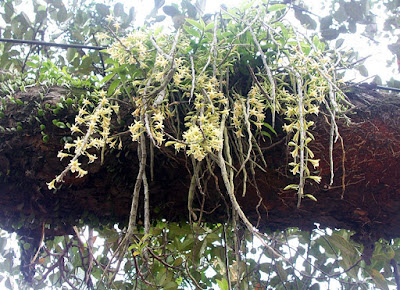Dendrobium macrostachyum is found in India, Myanmar, Sri Lanka, from the Himalayas to eastern Malesia and on the Cape York Peninsula as far south as the McIlwraith Range. It grows often on orchard trees in lowland rainforest at elevations around 1200 meters above sea level.
Dendrobium macrostachyum also called as The Large Inflorescence Dendrobium, The fringed tree orchid, Callista macrostachya, Dendrobium tetrodon, Dendrobium stuartii, Callista stuartii, Callista tetrodon, Dendrobium gamblei, Dendrobium viridicatum, Dendrobium tetrodon var. vanvuurenii, Dendrobium whiteanum, is a species of the genus Dendrobium. This species was described by John Lindley in 1830.
IDENTIFY DENDROBIUM MACROSTACHYUM ORCHID PLANT
Dendrobium macrostachyum is found in India, Myanmar, Sri Lanka, from the Himalayas to eastern Malesia and on the Cape York Peninsula as far south as the McIlwraith Range. It grows often on orchard trees in lowland rainforest at elevations around 1200 meters above sea level.
The Large Inflorescence Dendrobium is a small to medium sized, hot to cool growing epiphyte with thin pendulous, 100-600 mm long and 4-5 mm wide stems carrying many, thin, ovate-oblong to ovate-lanceolate, deciduous, acute, 50-80 mm long and 20-25 mm wide leaves.
The fringed tree orchid blooms in the late spring on a short, arising on the nodes of leafless stems after the leaves have dropped, 2 to 3 flowered inflorescence. The flowers are white to lime green. The edges of the labellum are hairy and there are three hairy ridges along its midline.
DENDROBIUM MACROSTACHYUM ORCHID PLANT CARE AND CULTURE
Cultural information should only be used as a guide, and should be to be adapted to suit you. Your physical location; where you grow your plants, how much time you have to devote to their care, and many other factors, will need to be taken into account. Only then can you decide on the cultural methods that best suit you and your plants.
Light:
Dendrobium macrostachyum like plenty of light, but cannot stand the full noonday rays of the sun (15000-40000 lux, filtered or diffused light is recommended.). These usually do best when placed so that they can get the early morning sun, but are shaded from about 10 a.m. onwards in the Summer time. In the Winter they can usually stand the sun's rays up to 11.30 a.m.
Temperature:
The average temperature of the summer day is 30-32 ° C, night 22 ° C, giving a daily difference of 8-9 ° C. In winter the average day temperature is 28-31 ° C, night 11-13 ° C, giving a daily difference of 15-18 ° C.
Humidity:
For most of the year, The fringed tree orchid need the humidity of almost 80%, but at the end of winter and at the beginning of spring it drops to around 60%. Too dry air has a negative effect on the development of the plant: its growth is inhibited, and the leaves begin to turn yellow and dry out. The higher temperature, the higher the humidity should be, and the higher the humidity, the more often and longer it is necessary to ventilate the room where the plants are contained, otherwise the probability of rotting and various kinds of fungal diseases.
Substrate, growing media and repotting:
Dendrobium macrostachyum grows best in pots with staghorn peat as substrate (crocks and charcoal at the bottom of the pot). After potting, keep the plant in a cool, shady place for a few days before placing it in its growing position. Do not overpot. Use the smallest pot that will accommodate your plant.
It does not need frequent repot, therefore, it is desirable to transplant only when it is really necessary, for example, in cases of strong salinization or compaction of the substrate, at its critically high or low pH (the norm is from 5.5 to 6.5) or when the plant grows very strongly and the pot becomes cramped to it (pseudobulbs begin to hang from the edges of the pot). Repotting is best done immediately after flowering when new roots and new growth begin to grow.
Watering:
The Large Inflorescence Dendrobium will need heavy watering from the commencement of Summer until the first chill spell of Autumn, when watering should practically cease until the new shoots appear in Spring.
Watering is directly dependent on the temperature of the content, the higher it is, the more often it needs to be watered. When watering, excess water should flow freely from the pot, since stagnation of water both inside the pot and in its pan can very quickly lead to rotting of the roots and the lower part of the plant.
Fertilizer:
It is recommended to use a 1/4-1/2 dose of orchid fertilizer weekly. You can use the balanced fertilizer throughout the year or from spring to mid-summer use high-nitrogen fertilizer, and then until the end of autumn high-phosphoric fertilizer to stimulate flowering.
Rest period:
Dendrobium macrostachyum need less water in the winter, especially if they grow under the conditions of a dark, short day that occurs at moderate latitudes. They should dry somewhat between waterings, but they should not be dry for a longer period. Frequent morning fogging and rare, economical watering should allow the plant to go through a dry period of rest, while providing it with sufficient humidity. Fertilization should be reduced or eliminated until new growths appear and a more abundant spring watering begins.

















COMMENTS